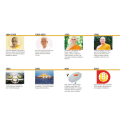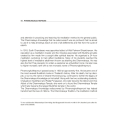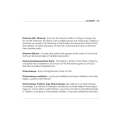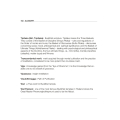Buddhist Scriptures : ค้นหาหนังสือธรรมะ หน้า 9 / 51
หน้าหนังสือทั้งหมด

6
Creating Harmony and Understanding in Family and Society
Part Three ~ Harmony in the Family 157
Chapter 15 Creating Harmony in the Family 159
Chapter 16 What Should Parents Do When Their Children Do Not Get Along? 165
Chapter 17 Remedying the Situation When
This section explores vital aspects of family dynamics, including creating harmony, handling sibling conflicts, and instilling compassion in children toward vulnerable relatives. It further delves int

164
Understanding the Fruitful Elderly: A Guide to Altruism and Wisdom
The second type of elderly person is called “A Fruitful Person,” a philanthropist or altruist. Throughout their lives, these elderly people have diligently earned their livelihood, and are well prepar
The second type of elderly individual, termed 'A Fruitful Person', exemplifies philanthropy and self-sufficiency. These individuals have not only prepared well for their later years but have also enga

181
Understanding External and Internal Fools in Buddhism
1) External Fools include non-Buddhists. They are determined to demolish Buddhism, whether they are of other religious affiliations or not. They typically try to cast aspersions upon Buddhist monks. W
In Buddhism, External Fools are non-Buddhists who seek to distort and undermine Buddhist teachings, casting aspersions on monks and creating confusion. Internal Fools, on the other hand, are Buddhists

3
Garudhamma 8 and Gender Equality in Early Buddhism
Abstract:
Garudhamma 8, What did the Lord Buddha Establish?
by Wilaiporn SUCHARITTHAMMAKUL
This paper deals with the Buddhist outlook on gender issues.
Contemporary feminists have extrapolated moder
This paper investigates the debate surrounding the eight garudhamma and their perceived authenticity in Buddha's teachings, analyzing gender equality in early Buddhism. It reviews claims challenging t

68
โครงวัลประกาศเกียรติคุณจากบุคคลสำคัญในศาสนาพุทธ
โครงวัลประกาศเกียรติคุณ จาก Mr. Ratnasiri Mutukumara / คุณรัตนสิทธิ์ มุทกุมาระ
World Fellowship of Buddhist Youth Sri Lanka / องค์การยุทธศาสนสัมพันธ์แห่งประเทศไทยรีกงา
โครงวัลประกาศเกียรติคุณ จาก Anu
เนื้อหานี้เป็นการรวบรวมโครงวัลประกาศเกียรติคุณที่มอบให้กับบุคลากรและองค์กรที่มีบทบาทสำคัญในการส่งเสริมและปกป้องศาสนาพุทธ ไม่ว่าจะเป็นจากคุณรัตนสิทธิ์ มุทกุมาระ สังกัด World Fellowship of Buddhist Yout

49
International Buddhist Conference: Buddhism into the Year 2000
7-10 February 1989, the Dhammakaya Foundation hosted the International Buddhist Conference "Buddhism into the Year 2000" at Sukhothai Dhammadhiraj Open University with a thirty national and internatio
Between 7-10 February 1989, the Dhammakaya Foundation organized the International Buddhist Conference titled 'Buddhism into the Year 2000' at Sukhothai Dhammadhiraj Open University. This event feature

57
The Concept of Dhamma and Kāya in Buddhist Philosophy
On the whole, it appears that the terms dhamma and brahma constituting four designations of the Tathāgāta are used in the sense of the ‘highest.’ It is most likely that they refer to Nibbāna.
This i
This study examines the terms dhamma and brahma, suggesting that they refer to the highest aspect of Tathāgāta, likely Nibbāna. The term dhamma denotes transcendental realities, transcending the realm

85
Academic Studies on Buddhism
Mus, Paul. Barabudur: Sketch of a History of Buddhism Based on Archaeological Criticism of the Texts. New Delhi: Indira Gandhi National Centre for the Arts: Sterling Publishers, 1998.
Need, David Nort
This collection features key academic contributions to the study of Buddhism, drawing from archaeological criticism, doctrinal analyses, and comparative studies between traditions. Works by notable sc

134
Exploring Daoist and Buddhist Visualization Techniques
The second one is the "Golden Palace" which is located below the heart and spleen, and the last field is the "Mud Pill Court" or the Palace of Ni-wan which is located about three inches within the hea
The text discusses the Golden Palace and the Mud Pill Court in relation to Daoist meditation. It highlights the visualization techniques associated with the cinnabar field, emphasizing its significanc

135
Buddhist Influence on Daoist Visualization Techniques
meditation. Lokakṣema translated Foshou banzhou sanmei jing 佛說般若三昧經 Pratyutpanna Samadhi-sūtra or “The Samadhi of Being in the presence of all the Buddhas”, which is the Visualization of Buddha or Bud
This text discusses the translation of Buddhist sutras like the Pratyutpanna Samadhi-sūtra and their influence on Daoist visualization techniques. It highlights how practices such as Buddhānusmṛti and

136
The Influence of An Shigao on Meditation in Eastern Han China
Conclusion
In conclusion, in this paper I have reviewed An Shigao's career as a meditation master and a translator of Buddhist texts. Based on his translations of meditation sutras I have argued that
In this conclusion, I highlight An Shigao's significant contributions as a meditation master and translator of Buddhist texts. His translation of meditation sutras introduced mindfulness breathing med

40
Analysis of Milindapañha Recensions
MIZUNO, K.
1959 “On the Recensions of Milindapañha” in Komazawa Daigaku kenkyu kiyo, (Summary of the Research Studies of University of Komazawa]), 17-55. Chinese Translation: 關於《彌蘭陀王問經》類, 水野弘元《佛教文獻
This text discusses the various recensions of the Milindapañha across multiple translations. Key contributions include K. Mizuno's analysis in 1959 published in the Komazawa Daigaku kenkyu kiyo, along

3
การแปลพร้อมเชิงอรรถวิเคราะห์ของ Samayabhedoparacanacakra
Samayabhedoparacanacakra: คำแปลพร้อมเชิงอรรถวิเคราะห์ (1) 69
An Annotated Translation of the
Samayabhedoparacanacakra into Thai (1)
Maythee PITAKTEERADHAM
Abstract
The Samayabhedoparacanacakra, co
Samayabhedoparacanacakra ที่ประพันธ์โดยพระเถระ Vasumitra ของนิกาย Sarvāstivāda มีอยู่ในฉบับแปลภาษาจีนสามฉบับและฉบับทิเบตหนึ่งฉบับ โดยรายงานประเพณีที่สำคัญเกี่ยวกับวันปรินิพพานและการแตกนิกายครั้งแรก บท

102
Buddhist Monastic Community
Phra Wijarn Teerungguro Phramaha Prasetkit Sumedho
Phra Wirot Virocano Phramaha Somchai Thanavuddho (M.D., Ph.D.)
Phra Wut Abhiwutdo & Vehicle Services Division Phramaha Supoj Suv
This text highlights various prominent Buddhist monks, including their titles and affiliations. It provides insights into their contributions to the community and the organizations they represent. Key

111
หลักฐานธรรมาภายในคัมภีร์พุทธโอวาท 1
หลักฐานธรรมาภายในคัมภีร์พุทธโอวาท 1 ฉบับรวบรวมงานวิจัยโดยอ้อ
Hoernle, A.F.R., F.E Pargiter, and Sten Konow. 1916. Manuscript Remains of Buddhist Literature Found in Eastern Turkestan: Facsimiles with
เอกสารนี้เป็นการรวบรวมและทำการวิจัยเกี่ยวกับคัมภีร์พุทธโอวาท รวมถึงการศึกษาเอกสารที่พบในตุรกีตะวันออก ขอบเขตเนื้อหาครอบคลุมถึงพระสูตรและการศึกษาโลกรู้ของนิกายมหายาน เช่น คัมภีร์ ลังกาวาตาระและทบทวนควา

20
History of Wat Phra Dhammakaya and Key Figures
1884-1959
The Great Master Phramongkolthepmuni, Abbot of Wat Paknam. Discoverer of the Dhammakaya Meditation Method.
1909-2000
Khun Yai Chand Khonnokyoong, founder of Wat Phra Dhammakaya (the Dhammak
The history of Wat Phra Dhammakaya traces its origins to influential figures such as Phramongkolthepmuni, the Great Master and discoverer of the Dhammakaya Meditation method. Khun Yai Chand Khonnokyoo

48
Phramongkolthepmuni: A Legacy of Dhammakaya Meditation
44 PHRAMONGKOLTHEPMUNI
and attention in practicing and teaching his meditation method to the general public.
The Dhammakaya Knowledge that he rediscovered was so profound that he aimed
to use it to h
Phramongkolthepmuni, originally Sodh Chandasaro, became abbot of Wat Paknam Bhasicharoen in 1918. Known for his meditation mastery, he organized workshops leading many to attain the Dhammakaya level.

159
Glossary of Buddhist Terms
GLOSSARY 155
Dhamma (Skt. Dharma): the truth; the natural condition of things or beings; the law of their existence; the ethical code of righteousness; the whole body of religious doctrines as a sys
This glossary outlines significant Buddhist terms. Dhamma refers to truth and the natural law of existence as taught by the Buddha. Dhammacakkappavattana Sutta is recognized as the Buddha's first teac

166
Understanding the Tipitaka and Buddhist Concepts
Tipitaka (Skt, Tripitaka): Buddhist scripture. Tipitaka means the Three Baskets. They consist of the Basket of Discipline (Vinaya Pitaka) – rules and regulations of the Order of monks and nuns; the Ba
Tipitaka, or Tripitaka, consists of three main sections: Vinaya Pitaka, Sutta Pitaka, and Abhidhamma Pitaka, covering monks' rules, discourses on various human concerns, and psychological aspects of B

35
Study of Buddhist Texts and Sectarian Developments
HONJŌ, Yoshifumi (本庄良文).
1992 “Saurātantika.” Indogaku-Bukkyōgaku-kenkyū 印度学仏教学研究 40(2): 148-154(L).
NATIER, Janice J., Charles S. PREBISH.
1977 “Mahāsāṃghika Origins: The Beginnings of Buddhist Sect
This compilation includes vital research contributions on Buddhist sectarian origins and the study of specific texts. Notable works such as Yoshifumi Honjō's study on Saurātantika and Janice Natier's
